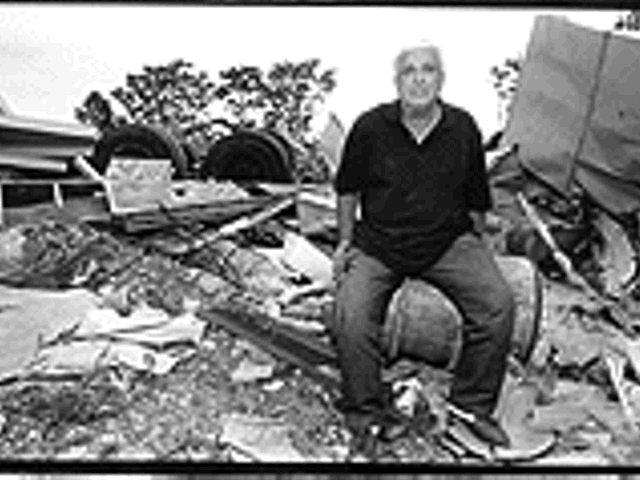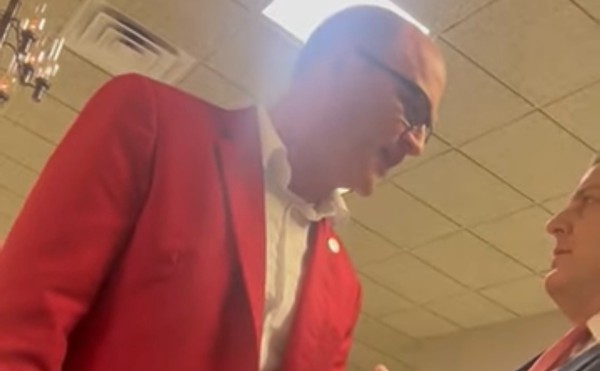Ask people how much money from the sale of a $200 commemorative baseball bat should go to a charity when media coverage vaguely states that bat sales will benefit charity, and the answer's not so fast or simple.
How does $10 out of $199 sound? Not nearly as good as a possible $50,000 divided between the Ronald McDonald House and Cardinals Care, the two charities set to receive funds from the sale of a commemorative Mark McGwire bat being sold as part of the frenzy over the big guy's 500th home run. The promotion is being produced by Nikco Sports, a St. Louis firm. The bats being sold are the type of Rawlings bat McGwire uses, but painted gold and laser-engraved with a copy of his signature and a few paragraphs about the 500th home run. Unadorned and un-numbered, the same bat retails locally for under 50 bucks.
This is the basic deal: For each bat sold, Ronald McDonald House gets 5 bucks and Cardinals Care gets 5 bucks. If all 5,000 numbered bats are sold, that adds up to $25,000 apiece for the two charities. So far, about 2,000 bats have been sold, so each recipient will get at least $10,000. So everyone should be happy, no?
Well, yeah, but if you do the math, if Nikco sells 5,000 bats at $200 per, that's a million bucks. Five percent of that, 50,000 simoleons, will go to charity. Granted, 5 percent of something is better than 100 percent of nothing, but the rub comes in the promotion. Is the public given a false impression by fast-and-loose statements by media? Again, there's no easy answer.
The free air time or print space given to the promotion is often short on details about how much of the total cost of $221.90 (including shipping and tax) will actually go to benefit the families of children with cancer who depend on the city's two Ronald McDonald Houses and the numerous children's charities that receive money from Cardinals Care.
A typical television-sports treatment of the bat sale was done by KTVI's Randi Naughton on Aug. 16, during the 5 p.m. newscast. Naughton said that the two charities "will benefit from portions of the proceeds of the sale of these bats." A Nikco spokesman was quoted, as was a Ronald McDonald House spokesman. The mother of a child with cancer was interviewed and said the house "makes you feel at home." Naughton ended with how "this couple's never been to a baseball game. But they're feeling the effect players like Mark McGwire and fans are having on their family."
Nowhere in Naughton's comments is the price of the bat mentioned, or what percentage of the sales the charities will receive.
An even more misleading presentation was given to anyone who glanced over the Aug. 12 sports section of the Post-Dispatch and saw this headline: "McGwire Bats Are Being Sold to Benefit Charity." Technically, that's not an untrue statement. One sentence noted that a "fundraising goal of $50,000 has been set," but the three paragraphs with photo likely gave readers the impression that more than 5 bucks of the $221.90 they'd pay for one of the wooden bats was going to either charity.
Dr. Edward Lewis, director of Cardinals Care, is keenly aware of the issues related to charity fundraising. It's a tightrope, strung between ethics and reality, that he walks with care. "It's always a little difficult when you're in the business of fundraising for charity," says Lewis. "Your primary initiative is to raise as much money as you can, and people who are generous enough — corporate sponsors — to include us, we don't want to seem ungrateful by saying, "Well, gee, this is not a significant enough level for us to participate,' and walk away from it. Then you second-guess yourself, too, if you're doing the right thing."
The first consideration is the overall donation. In this case, $25,000 is a lot of money. Plus, Lewis said Nikco last year contributed $47,000 to Cardinals Care from the sale of other commemorative items, so there is a history with the company. He admits that if this had been his first contact with Nikco, he "would have taken a harder look at the percentage involved here." But Nikco's owner and president, Joy Bidner, he says, has been "generous" in prior dealings. The way promotional materials are worded is vital, Lewis says.
"I'm always uncomfortable — in fact, we don't even allow statements like a "portion of the proceeds benefit Cardinals Care,' because that's a meaningless statement," says Lewis. "You really need to define the donation in terms of a percentage of the retail, or a flat amount like this $5 contribution."
But once the press release is sent, how the media word their reports is in their control.
"The Post-Dispatch had one in there a week ago that I was very uncomfortable with, because the headline was "McGwire Bats Sold for Charity,' or something like that," says Lewis. "I almost called Joy, but I got busy with a few other things. I was really disappointed that that story was written the way it was. The last thing that should happen is that customers, fans, collectors be misled about where this $200 is going. They should know exactly if that is a factor in their decision."
But overall, Lewis is not upset, just watchful: "There's always somebody out there trying to make a negative even when a company is trying to do a positive thing. I trust that Joy represents it properly."
For her part, Bidner is far from apologetic about linking sports marketing, charity, profit and McGwire mania.
Siphoning 10 bucks a bat from the $221.90 collected is what Nikco is able to do "based on the cost structure," she says, rattling off the expense of a toll-free number, a seven-person sales staff and a "pretty hefty price" to Rawlings that includes a fee to McGwire. "I can't go into any of that — that's clearly confidential information. We pay Rawlings a cost, and, built into that cost, Mark McGwire is paid a certain amount," says Bidner.
"We could choose not to give to a charity and simply advertise," she says, but she notes that this strategy isn't always as effective. "Frankly, when I've done advertising in the past, it has not been nearly as effective as when I work closely with the media and charity to sell product. We felt this is a win-win-win. If I can spend $50,000 and give it to charity, vs. giving it to folks to advertise — which, like I said, in the past has not been as effective — I would much prefer to help small children and people in the process."
To Dan Harbaugh, executive director of the Ronald McDonald House, the offer from Nikco was not a trick question: a large donation, no work required and, as for Nikco, a lot of free publicity. "Beggars cannot be choosers," Harbaugh says. "It was easy for me to pick up the phone and say, "Yeah, thank you very, very much.' So we're blessed to be the beneficiary."
Bidner says sales of sports memorabilia nationwide by Nikco have raised about $300,000 for various charities in the last six years. She can't see why anyone would put a negative spin on the bat sales.
"I would challenge those who are cynical about it — what money have they given to charity recently?" Bidner asks.
For anyone who just bought the $221.90 baseball bat, the answer is 10 bucks.





